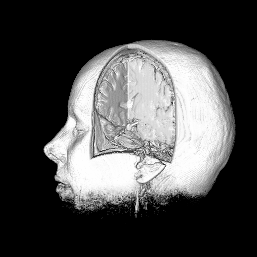 |
| Volume Visualization (VolVis) generally refers to the rendering of a scalar volumetric datset (possibly resulting from texture synthesis of a 3D vector / flow field). Based on the conventional Surface Graphics (in which an object is modeled by patched polygons on the surface --- empty inside), iso-surface techniques such as Marching Cubes [1], Dividing Cubes [2], and Marching Tetrahedra [3] work by fitting intermediate geometric primitives (e.g., triangles, Figure 1.a) to a threshold-defined 2D manifold prior to surface rendering (typically accelerated using commodity graphics cards and even Graphical Processing Units --- GPUs, Figure 1.b). Based on the increasingly established Volume Graphics (in which an object is modeled by solid volumetric elements --- voxels), direct volume rendering (volume rendering for short) techniques such as Ray Casting [4], Splatting [5], Cell-Projection [6], [7], [8], Shear-Warp [9], and hardware-based 2D / 3D texture mapping [10] eliminate the need for the construction of any intermediate representation, but instead operate on voxels by using a light absorption-emission model (used to approximate the interaction between light and the volume) and a transfer function (a map / transform used to emphasize or suppress part of the data from the rest) to assign colors and opacities (RGBA) to the voxels that are then sampled and composited or blended (through integral convolution) along the view direction (Figure 2). Volume rendering can also be implemented in the frequency domain [11], [12]. To provide a context for enhanced depth cueing and orientation, geometric objects such as arbitrarily-aligned clipping planes or surgical devices (e.g., scalpel) are sometimes rendered in combination with voxel-based volume data [13]. Iso-surfacing is good at displaying relatively simple or regular contour surfaces and at measuring surface area and volume, whereas volume rendering is well suited for delineating the distribution of some physical property (e.g., density, temperature, and pressure) within a dense volume and for representing amorphous transparent gel-like objects such as clouds, smoke, and fluid flows that are too complicated to be geometrically modeled using polygons. Hybrid Rendering incorporates iso-surfacing and volume rendering in the rendition of a single view and hence exploits the advantages of both. |
|
|
|
Figure 1. Iso-surface extraction
(via marching cubes) and rendering (©
Zhanping Liu).
|
|
|
|
Figure 2. Ray casting for volume
rendering (©
Zhanping Liu).
|